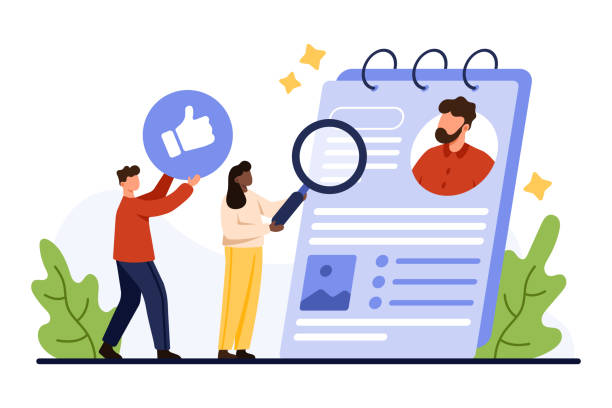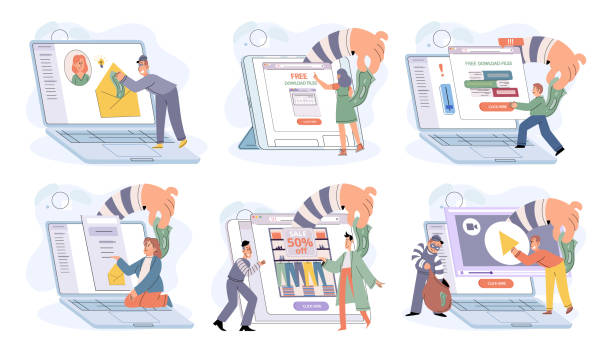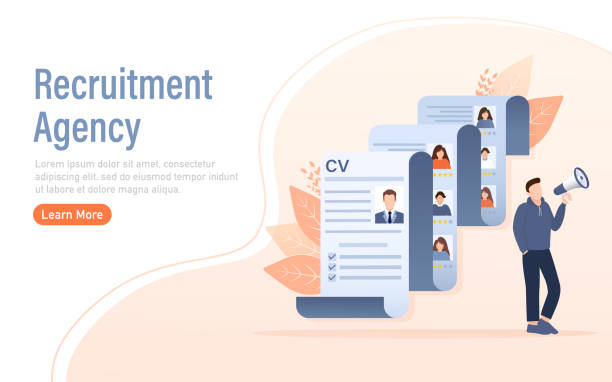Introduction to User-Friendly Website Design and Its Importance

In today’s world, where the internet has become an inseparable part of our daily lives, having a website is no longer an option but a necessity.
However, simply having a website is not enough; true success is achieved when website design is user-friendly and optimized.
Website design with a #user-centric approach means creating a digital space where visitors can easily interact with it, find the information they need, and have a pleasant experience.
The importance of this is that an unsuitable site can lead to a high #bounce_rate and the loss of potential customers, while a successful design converts users into loyal customers.
This chapter, in an #explanatory and #educational manner, delves into the fundamental concept of user-friendly website design and clarifies why it is crucial in today’s digital ecosystem.
Indeed, the ultimate goal of any online business should be to provide an unparalleled #user_experience so that users not only visit the site but are eager to return and re-engage with it.
This approach will be the winning card for any business, especially in today’s competitive markets.
Do you dream of a thriving online store but don’t know where to start?
Rasaweb is your comprehensive e-commerce website design solution.
✅ Attractive and user-friendly design
✅ Increase sales and revenue⚡ Get Free Consultation
Fundamental Principles of User Experience (UX) in Web Design

User Experience (UX) is the core of user-friendly website design.
This concept goes beyond visual aesthetics and addresses all aspects of user interaction with the website.
Fundamental UX principles include Usability, Findability, Accessibility, Desirability, Credibility, and Value.
A user-friendly website should be designed so that navigation is intuitive; meaning the user knows how to access the desired information without needing to think too much.
One of the most important aspects of UX is web navigation, which must be clear, concise, and consistent.
Furthermore, User Interface (UI) design, which includes the layout of elements, colors, fonts, and images, should contribute to ease of use while maintaining aesthetic appeal.
This section, in a #specialized and #guidance manner, explains these principles and shows how each of these factors together contributes to creating a user-friendly site.
A deep understanding of these principles is essential for any web designer or business owner looking to improve interaction with their users.
Success in the online world heavily depends on correctly understanding and implementing these principles.
Impact of User-Friendly Design on SEO and Conversion Rate

Many believe user-friendly website design and SEO (Search Engine Optimization) are two separate categories, while they are strongly interconnected.
Search engines like Google aim to provide the best experience for their users, and therefore, websites with better user experience also achieve higher rankings in search results.
Factors such as site loading speed, responsiveness, easy navigation, and quality content are all vital for both UX and SEO.
Furthermore, a user-optimized design directly impacts the Conversion Rate.
When a user can easily find what they want, smoothly complete the purchase or registration process, and their trust is gained, the probability of them converting into a customer becomes much higher.
This section, in an #analytical and #explanatory manner, examines this correlation and shows how investing in a user-centric website design will yield significant returns in the form of increased traffic, better rankings, and ultimately, greater profitability.
The tables provided below will help you better understand the factors influencing SEO and conversion rates from a user-friendliness perspective.
| Factor | Explanation | Impact on User Experience (UX) | Impact on SEO |
|---|---|---|---|
| Site Loading Speed | Time required for web pages to fully load | Users dislike long waits, quick exit from the site | Important Google ranking factor, reduced bounce rate |
| Responsiveness (Responsive Design) | Site compatibility with various devices (mobile, tablet, desktop) | Consistent experience on every device, increased satisfaction | Google’s prioritization of mobile-friendly sites |
| Easy and Intuitive Navigation | Ability to quickly find information and different sections of the site | Reduced confusion, increased dwell time | Reduced bounce rate, increased page views |
| Quality and Relevant Content | Providing useful, engaging, and up-to-date information to the user | Building trust, increasing user engagement and return visits | Increased site authority, attracting backlinks, improved keyword ranking |
| Clear Call to Action (CTA) | Clear instructions for desired actions (e.g., purchase) | Ease of achieving the user’s desired goal | Increased conversion rate, positive signals to search engines |
Importance of Responsive Design in User-Friendly Website Design

In the current era, where mobile usage for internet access has become widespread, responsive design is no longer a luxury option but a necessity for any user-friendly website design.
Responsive design means your website can automatically adjust its layout and content to the size of the user’s device screen.
This means whether a user accesses your site with a desktop computer, a tablet, or a smartphone, they will have an optimal and flawless experience.
Without responsive design, users visiting your site on mobile devices will be forced to zoom, scroll horizontally, and encounter unsuitable layouts, which quickly leads to frustration and their departure from the site.
Google has also prioritized mobile-friendly sites for years, and this directly impacts SEO and website rankings.
This chapter, in a #guidance and #explanatory manner, discusses the importance of this aspect of design and provides key tips to ensure your website is responsive.
Having a website that displays well on all devices not only improves the user experience but also demonstrates the credibility and professionalism of your business.
Are you tired of your e-commerce website not generating as much revenue as it could? Rasaweb, specializing in professional e-commerce website design, solves this problem forever!
✅ Increase sales rate and revenue
✅ High load speed and unparalleled user experience
⚡ Get Free E-commerce Website Design Consultation
Content; A King That Must Be Designed for the User

Content is still king, but a king that must be designed for the satisfaction of its subjects (users).
In a user-friendly website design, content must not only be rich and relevant but also presented in a way that ensures high readability, easy access, and a logical structure.
Using clear headings, short paragraphs, bulleted lists, and relevant images and videos all help to attract and retain user attention.
#Thought-provoking or #entertaining content can increase user engagement, but the main purpose and value of the content for the user must always be maintained.
Does your content answer user questions? Does it provide new information? Is it inspiring? These are questions content designers should ask themselves.
This section, in an #educational and #guidance manner, addresses content creation and presentation strategies that are not only optimized for search engines but are specifically designed to improve the user experience.
The ultimate goal is for every visitor to quickly and enjoyably find and benefit from the content they need, which itself signifies a complete user-friendly site.
Good content alone can be a factor in users returning and increasing their dwell time on the site.
Site Loading Speed; A Crucial Factor for User Satisfaction

One of the most important factors in user-friendly website design and user retention is site loading speed.
Studies have shown that even a few seconds delay in page loading can lead to the loss of a significant portion of visitors.
Today’s users are impatient and expect pages to load instantly.
Slow site speed not only negatively impacts user experience but also directly affects SEO; search engines prefer faster sites.
Several factors influence site speed, including image optimization, code compression (CSS, JavaScript, HTML), using a CDN (Content Delivery Network), choosing suitable hosting, and implementing caching.
This chapter, in a #specialized and #guidance manner, examines these factors and provides solutions for increasing site speed.
We explain how each of these actions can help improve your website’s overall performance and, consequently, enhance your user-friendly site design.
Investing in site speed optimization is an investment in user satisfaction and the long-term success of your online business.
Reducing load time to less than two seconds should be a primary goal for every website.
Web Accessibility; Design for Everyone

Web Accessibility means designing a user-friendly site in such a way that people with disabilities can fully access and use its content and functionalities.
This includes individuals with visual, auditory, motor, cognitive, and neurological impairments.
Ignoring accessibility is not only ethically wrong but can also lead to losing a large segment of users and even legal issues.
An accessible website uses tools such as alternative text for images, captions for videos, keyboard navigation, adequate color contrast, and semantic HTML structure.
These principles are defined by the Web Content Accessibility Guidelines (WCAG).
This chapter, in an #explanatory and #analytical manner, discusses the importance of accessibility and shows how by correctly implementing these principles, we can create a user-friendly website design for everyone.
Adhering to these standards not only demonstrates a business’s social responsibility but can also expand your target market.
Below, an initial checklist is provided to help you evaluate and improve your website’s accessibility.
| Feature | Explanation and Importance | How to Implement |
|---|---|---|
| Alternative Text (Alt Text) for Images | A short description for images, for users with visual impairments and SEO | Add the alt attribute to the <img> tag |
| Sufficient Color Contrast | Appropriate difference between text and background color for better readability | Use contrast checker tools (such as WCAG Color Contrast Checker) |
| Keyboard Navigation | Ability to access all parts of the site using only the keyboard | Ensure :focus states for links and forms, use semantic tags |
| Captions and Transcripts for Multimedia Content | Provide text for audio and video files for deaf or hard-of-hearing users | Add VTT files for videos, provide full text for podcasts |
| Use of Semantic HTML Tags | Utilize tags like <header>, <nav>, <main>, <footer> |
Helps assistive technologies understand page structure |
| Accessible Forms | Clear labels for form fields, understandable error messages | Use the <label> tag for each field, provide clear instructions |
Continuous Testing and Optimization; The Key to a Sustainable User-Friendly Site

After initial design and implementation of user-friendly website design principles, the work is not over.
A website is a living entity that requires continuous monitoring, testing, and optimization.
User behavior, technologies, and expectations are constantly changing.
Usability Testing helps you identify the strengths and weaknesses of your design from the perspective of real users.
These tests can include A/B testing, Heatmaps, eye-tracking, and user surveys.
Collecting user feedback and analyzing behavioral data (such as bounce rate, dwell time, and click paths) is crucial for identifying problems and opportunities for improvement.
This section, in an #educational and #guidance manner, shows you how to establish a continuous feedback loop so that your website consistently remains a user-friendly website and adapts to current needs.
Continuous optimization not only helps increase user satisfaction but also leads to the sustainable growth of your business.
This dynamic process ensures long-term success in the digital world.
Are you dissatisfied with the low conversion rate of visitors to customers on your e-commerce site?
With professional e-commerce website design by Rasaweb, solve this problem forever!
✅ Increase visitor-to-customer conversion rate
✅ Create an excellent user experience and build customer trust
⚡ Get Free Consultation
Security and Trust; The Foundation of a Reliable User Experience

One of the often-overlooked aspects of user-friendly website design is security and trust-building.
Users will only feel comfortable and confident on a website when they are assured of the security of their personal and financial information.
The presence of an SSL certificate (HTTPS protocol), Trust Badges, clear privacy policies, and valid contact information all contribute to building trust.
Any security flaw or lack of transparency can quickly lead to the loss of user trust and their departure from the site.
This issue is particularly critical for e-commerce websites that handle sensitive information.
This chapter, in an #explanatory and #specialized manner, discusses the importance of these dimensions of user-centric website design and shows how by creating a secure and reliable environment, you can enhance the user experience and encourage users to interact more and make transactions.
A secure and reliable site is not only technically important but also psychologically has a significant impact on the user’s decision to continue interacting with the website.
The Future of User-Friendly Website Design; Trends and Predictions
![]()
The world of user-friendly website design is rapidly evolving, with new trends constantly emerging.
Key future trends include increased use of Artificial Intelligence and Machine Learning for personalizing the user experience, Voice User Interfaces (Voice UI), Augmented Reality (AR) and Virtual Reality (VR) on the web, and design for smart devices and the Internet of Things (IoT).
The importance of minimalist design and rich visual content will also continue.
Furthermore, an emphasis on greater accessibility and the environmental sustainability of websites (Green Web Design) are also future trends.
This chapter, in a #news and #analytical manner, examines these trends and predictions, providing you with an insight into how user-friendly website design will evolve in the coming years.
Being prepared for these changes and integrating them into your design strategies can help you stay a step ahead of competitors and offer a website that is attractive and effective for users not only today but also in the future.
These advancements promise an even more personalized and immersive user experience.
Frequently Asked Questions
And other services of Rasaweb Advertising Agency in the field of advertising
Smart Link Building: A novel service to enhance customer behavior analysis through precise audience targeting.
Smart Advertising Campaign: A combination of creativity and technology for online growth through custom programming.
Smart SEO: Designed for businesses seeking to increase click-through rates through attractive user interface design.
Smart Marketing Automation: A blend of creativity and technology for digital branding through intelligent data analysis.
Smart Advertorial: A creative platform for improving online growth with intelligent data analysis.
And over hundreds of other services in internet advertising, advertising consultation, and organizational solutions
Internet Advertising | Advertising Strategy | Advertorial
References
User-Friendly Website Design and Its Impact on Business
The Importance of UI and UX in Digital Marketing Success
The Role of Website Design in Improving SEO and Business Growth
Principles of Successful Website Design for Online Businesses
? Are you looking to elevate your business in the digital world? Rasaweb Afarin Digital Marketing Agency, by providing comprehensive SEO-optimized website design services, helps you shine online and achieve your goals. With us, experience a powerful and memorable presence.
📍 Tehran, Mirdamad Street, next to Bank Markazi, Southern Kazeroon Alley, Ramin Alley No. 6


